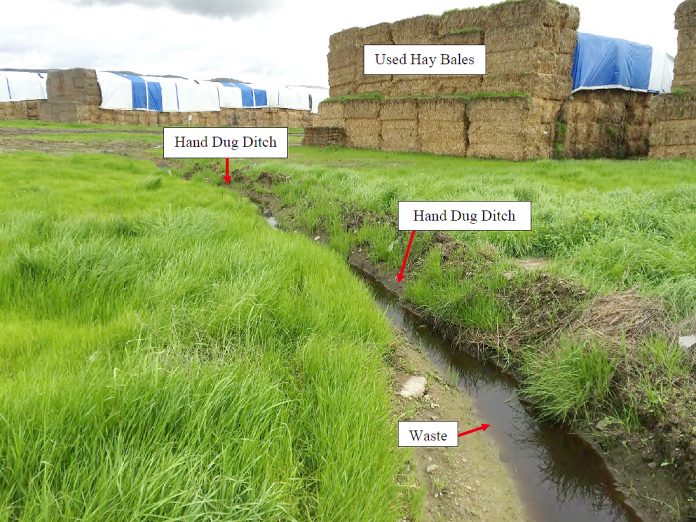
Monterey Mushrooms’ history of allowing its farm production waste and other wastewater to flow from its Morgan Hill facility into local waterways is extensive, according to the district attorney’s civil complaint against the company.
Recorded incidents of such wastewater flow from the mushroom-growing site on Hale Avenue into Fisher Creek and its tributaries date back more than 30 years and have occurred on dozens of occasions observed by enforcement authorities, the lawsuit filed Dec. 21 by the Santa Clara County DA’s Office states.
Similar illegal wastewater dumping practices have been logged at other Monterey Mushrooms facilities in the Central Coast region, and authorities outside Santa Clara County are still working with the company to correct the more recent violations, according to multiple sources.
The local lawsuit addresses suspected violations of state Fish and Game and Business and Professions laws from 2012 to 2017, a timeframe within the statute of limitations for the alleged crimes.
Despite the nasty-sounding nature of the allegations against Monterey Mushrooms, local officials have aimed to assure the public that their drinking water is not at risk. City of Morgan Hill spokeswoman Maureen Tobin noted that the mushroom-growing facility near Hale and Miramonte avenues is outside the city’s boundaries—about 1.5 miles north of the city limits—and Fisher Creek flows away from town to the north.
“Although the alleged discharges are far to the north of the city’s groundwater supply, residents should understand that the city has and continues to test water quality in order to ensure the water delivered to Morgan Hill is safe,” Tobin said in an email statement.
Morgan Hill’s public drinking water is drawn directly from the groundwater basin beneath the city.
Fisher Creek flows into Coyote Creek, which flows into the San Francisco Bay. Coyote Creek is home to steelhead trout, California tiger salamanders and California red-legged frogs.
The DA’s complaint alleges the environmentally harmful and unfair business practices have been deliberate and pervasive at Monterey Mushrooms, Inc.’s Morgan Hill site. DA Jeff Rosen’s lawsuit is asking the Superior Court for $67 million in damages for Monterey Mushrooms’ alleged repeated violations of the state Fish and Wildlife and Business and Professions codes.
The DA’s extensive lawsuit describes in detail and includes photos of how Monterey Mushrooms has allowed, and even manipulated its property to allow, the farming operation’s harmful production waste to flow off its property into Fisher Creek in north Morgan Hill.
Hay bales used for compost at the site—often made of used horse stable hay that may contain animal urine and feces—are pictured sitting directly next to the creek in one of the exhibits, with no barrier or collection pond to prevent rain water from washing material into the creek. On one incident in January 2016, Fish and Game wardens observed stormwater running off piles of used hay bales, “flowing through an intentionally hand-dug ditch and directly into a stream, Fisher Creek,” reads the DA’s complaint.
The lawsuit also alleges that employees of Monterey Mushrooms dug up sections of Fisher Creek’s banks without a permit, to remove weeds.
On Feb. 7, 2017, authorities estimated the Morgan Hill site pumped more than 345,000 gallons of wastewater into Fisher Creek. Much of the wastewater pumped into the creek from Monterey Mushrooms’ site, on multiple occasions, contained toxic levels of ammonia, according to the DA’s complaint.
In all, the DA’s complaint alleges 66 violations of state Fish and Game codes and one violation of unfair competition laws. The lawsuit alleges Monterey Mushrooms committed the violations in order to cut operation costs.
Monterey Mushrooms, one of the nation’s largest mushroom growers, operates other farms in California that fall outside the local jurisdiction. The DA included information about recent violations at these sites as well in the lawsuit, for background information.
Three other Monterey Mushrooms facilities where the company has allegedly diverted or pumped wastewater into creeks are in Royal Oaks, Watsonville and Arroyo Grande. The company is based in Watsonville.
These facilities fall within the oversight jurisdiction of the Central Coast Regional Water Quality Control Board. That board’s assistant executive officer, Matt Keeling, said these three sites have shown “similar types of violations (that) we’re currently working with Monterey Mushrooms to resolve.” The board has not yet fined or penalized the company, but it has the authority to do so, and such enforcement may later be on the table for Monterey Mushrooms, Keeling said.
The alleged violations at the Central Coast mushroom facilities date back to 2016, according to Keeling. When asked if wastewater runoff violations are pervasive at the three Monterey Mushrooms sites, Keeling said, “It does appear to be so.” The board’s goal at the moment is to make sure these facilities are in compliance with state Fish and Game laws.
In a statement in December, Monterey Mushrooms said it was “shocked” by the DA’s lawsuit. A company spokesman said the unpermitted flows of wastewater off the Morgan Hill site in 2016 and 2017 were not intentional, but were the result of torrential rain storms that occurred during the winter months.
The DA’s lawsuit also includes a history of Monterey Mushrooms’ violations at the Morgan Hill site going back to 1985. That year, regulators required the company to install an upgraded evaporation pond to the property in order to lawfully deal with production waste. The company asked for an extension on its deadline to install the pond due to the high cost of the project, but ultimately did not complete the evaporation pond until 2001, the DA’s lawsuit reads.
“During the 16 years (from 1985 to 2001), defendants remained in full production and unlawfully discharged their wastewater into (an) unlined percolation pond,” the DA’s complaint says.







